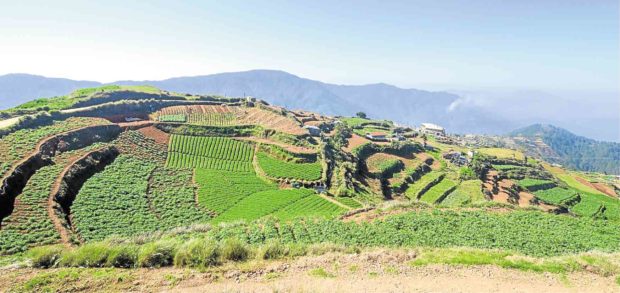Mt. Pulag zoning sought to curb farm, settlement expansion

Credit to Author: besguerra| Date: Mon, 01 Jul 2019 21:17:05 +0000
KABAYAN, Benguet, Philippines — Ibaloy and Kalanguya communities here want to take part in talks on forming management zones at the Mt. Pulag National Park that will prevent vegetable gardens from intruding further into one of the country’s most biologically diverse regions.
Each management zone will define the metes and bounds of mountain settlements and vegetable gardens, to set them apart from the dwarf bamboo grasslands and pristine mossy forests, which are home to rare species such as the greater dwarf cloud rat (Carpomys melanurus).
Mt. Pulag, Luzon’s highest peak, had been inhabited before a presidential proclamation established the 11,560-hectare national park, comprised of Mt. Pulag, Mt. Tabayoc and Mt. Panotoan. It straddles Kabayan, Bokod and Buguias towns in Benguet; Tinoc town in Ifugao; and Kayapa town in Nueva Vizcaya.
A census detailing how many people live within the park has not been made public but inhabitants have been barred from pursuing traditional activities such as hunting and gardening inside the protected area since the proclamation’s issuance in 1987.
Best strategy
Tension has also grown among the park’s managers, environment officials and residents, who resent seeking the agency’s permission every time they improve their homes, build classrooms or undertake livelihood programs, said incoming Mayor Faustino Aquisan.
Setting up zones remains the best strategy to preserve the environment with the help of Pulag’s indigenous residents, although “any plan not involving the community will be met by resistance,” he said.
“[But] while Mt. Pulag is our home, we also recognize its importance as a watershed and national park,” said Aquisan, who served as mayor from 2007 to 2016.
“Conflicts arose because the Ibaloys and Kalanguyas were never consulted on the establishment of a park in their ancestral lands,” he said.
Eight of Kabayan’s 13 villages make up 80 percent of the park. To the Ibaloy, Mt. Pulag is a sacred ground where the souls of the dead reunite with their ancestors and Kabunian, their divine creator.
Like many Benguet towns, some Pulag inhabitants have developed vegetable gardens to profit from a huge market demand for cabbages, carrots, beans, cauliflower and lettuce.
In 1992, the Department of Agrarian Reform granted eight certificates of land ownership award (Cloa) to Pulag dwellers farming 2,000 ha of land.
But the Department of Environment and Natural Resources (DENR) nullified the Cloa in 1998 after farmers asked for irrigation projects inside the protected area.
Tamed law enforcement
Settlements and farms have taken over 25 percent of the park, which have expanded into commercial enterprises, some encroaching further up the mossy forests 2,500 meters above sea level, because of “tamed law enforcement,” according to the 2010 book “Biodiversity and natural resources management in the Mt. Pulag National Park.”
The book says the expanding farms are the “single most destructive activity that threatens all biodiversity and natural resources” of the park.
The book’s findings were confirmed by the DENR in 2015 when it completed the delineation of the park.
Four management zones were first proposed in a Mt. Pulag National Park general management plan in 2000 to preserve the forest, under a joint project called the “National Integrated Protected Areas Program” of the government and the European Union.
The plan was rejected and Pulag residents have since fortified their stake over inhabited lands by paying tax declarations or by getting recognition that their properties are ancestral lands under the Indigenous Peoples’ Rights Act of 1997.
Indiscriminate approval
Overlapping ancestral domain and the indiscriminate approval of tax declaration certifications made it difficult at the start to put up a management zone for the inhabited portions of the park, said Ralph Pablo, DENR director in Cordillera.
Arguing they have prior rights as indigenous dwellers, the farmers have converted vast forest areas into vegetable farms in Bokod and Buguias, said Emerita Alba, Pulag’s protected area superintendent.
She said forest denudation worsened when the government built roads into the park, allowing farmers to use heavy equipment such as excavators and bulldozers to develop more gardens.
In 2014, forest rangers found 10 ha of forest had been cleared and more than 200 pine and oak trees had been destroyed in Bokod.
In 2016, then Kabayan Mayor Gideon Todiano said the management of the park should be delegated to the Ibaloy given the DENR’s failure to protect the forest.